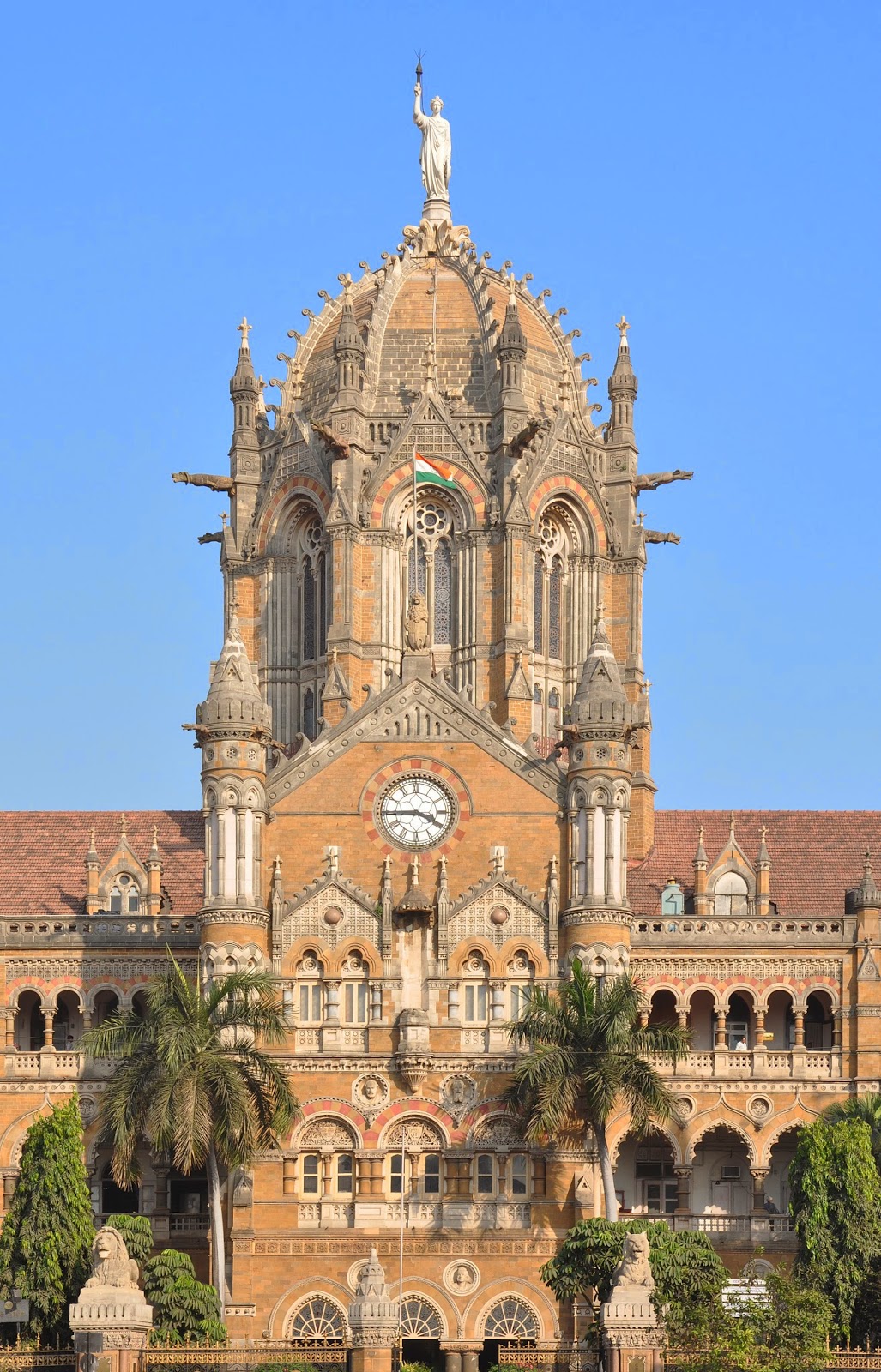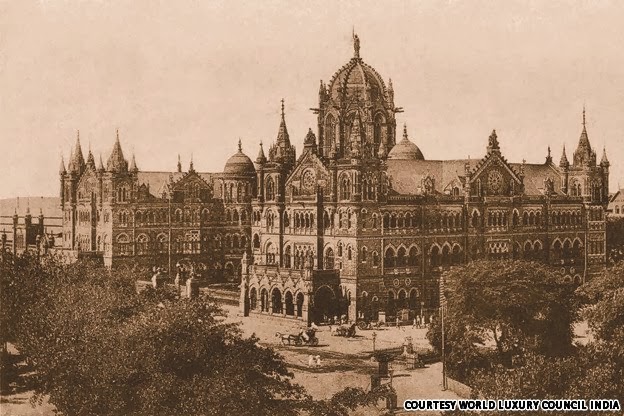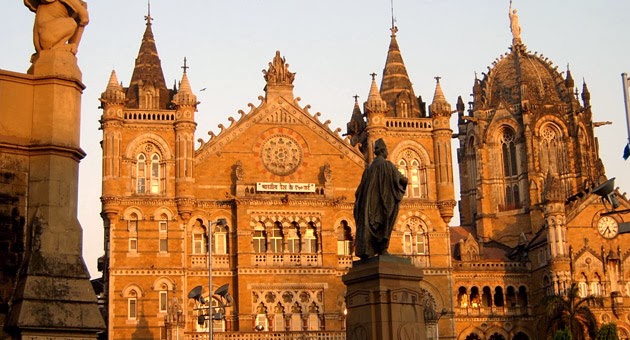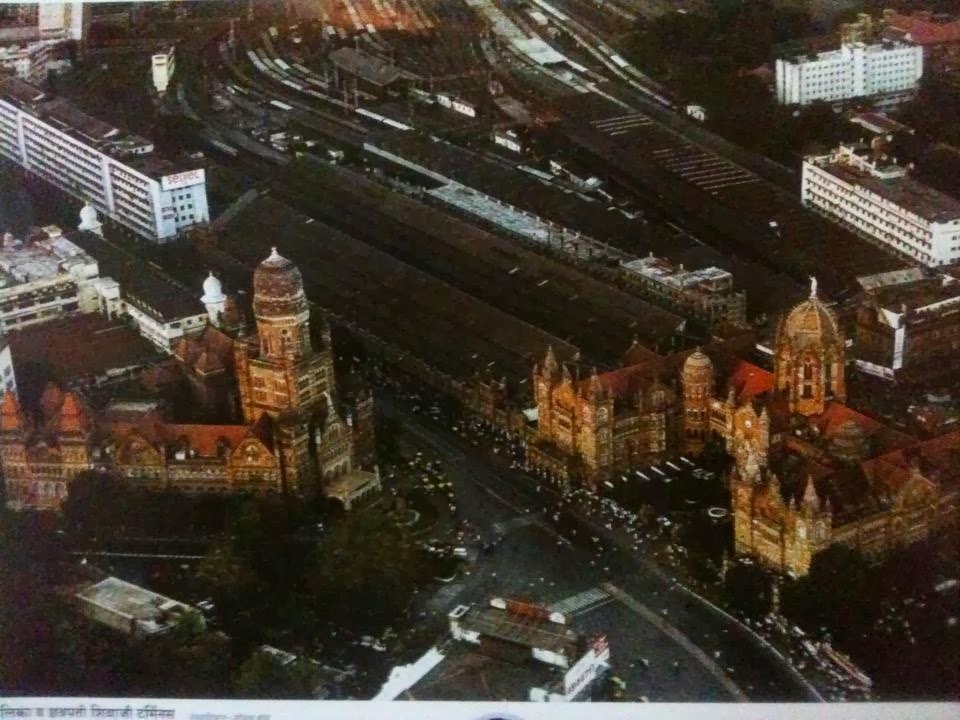Dec 17, 2025
Dec 17, 2025
by Ravi Pipal
Among the best and also one of the VERY early ones to be built is the Victoria Terminus in Bombay, at Boribunder. It derives its name from Queen Victoria because the station building was formally opened on Jubilee Day in 1887. Before 1852 when its first pier was constructed, Boribunder in Bombay was just a landing place for country boats. The first station at Boribunder was a ‘miserable wooden structure’; most of the upper class passengers boarded trains from Byculla which had a pretentious platform and an attractively built shed. Originally VT was intended to accommodate only the offices and the main station. Since 1887, additional buildings at adjoining sites have been erected. The annexed building was used as a hospital during 1914-18 World War and is now used for offices. The new station building was opened in 1929 to deal with the main line traffic. The additions were so designed as to harmonial with the architectural magnificence of the 1887 building and to create an impressive composite effect. The old and the new stations together comprise one of the largest and busiest terminals anywhere in the World.

The site on which VT is located is of great historical importance being associated with the very origin of Bombay as a city. Recent researches into old records show that Bombay derived its name originally from the Goddess Mumba Devi, or Maha Amba. The earliest temple dedicated to her is believed to have stood at the very place where VT was erected in 1887. The original shrine was demolished by Mubarak Shah better known as Qutab-ud-Din and was re-erected on 1317. It was again demolished in 1760 by the Portuguese. The tank adjoining the shrine continued to be preserved till 1805. A public gibbet or gallows was constructed by the Portuguese at the site of the tank, from whence the site and the tank derive the name Gibbet Pond.
Designed by the famous architect, F.W. Stevens in 1887 VT is gothic-Saracenic in style with a series of well proportioned and delicately ornamented arches, giving it the look of a grand cathedral. This effect is further heightened by a central dome set off by a number of smaller domes and conical towers reminiscent of Westminster Abbey. The lancet windows in the dome and towers are of ornate stained glass and like the rest of the building are made out of solid cut stone masonry, superimposed by delicate artistic work, designed in plaster. The apex of the dome is crowned by a colossal figure in stone symbolizing ‘progress’. This figure is 16 feet 6 inches in height. On the principal gables are displayed sculptural panels representing ‘Engineering Agriculture, Commerce, Science and trade. The arches and windows are Venetian by style and overlook a 1500 feet façade. The double columns which support the arches of the verandahs and the colonnades are of marble. Italian granite has been freely used for interior decoration. The old station was eight platforms while the new Main Line stations which is separated from the old station by a wide road consists of 18 passenger platforms and one platform for parcel traffic. Both stations have waiting halls, Station Master Office, booking offices and book stalls. In addition, the new station building contains a reservation and enquiry office, retiring rooms, restaurants and cloak and check rooms. Part of the buildings are also occupied by the administrative offices of Central Railway.

Employees:
‘The problems affecting railway labour in India’, wrote the Royal Commission on Labour in 1931 ‘are as varied as they are numerous’. There are several factors peculiar to each Railway which have an important bearing on the conditions of labour pertaining to that particular line. Among these are the lengths of the railway the territories through which it passes, the climate, ethnological and other features peculiar to these territories, and industrial progress made by the people living therein the scope such progress affords for the satisfactory recruitment of railway labour and the other avenues of employment open to labour.
It cannot be said of the Railway companies that the wages offered by them will substantially higher than those available to workers in other trade and industries or that the condition of work very much better. During the first 50 years according to Labour Commission, it was more or less a case of bargaining for the most favourable terms on both sides. The only notable amenity during this period was the institution in 1880 of a P.F.
It was not till World War -I that the railways began to give serious thought to the general welfare of low paid employees. During the war there was a substantial increase in wages and allowances became necessary and even cheap grain shops were opened to mitigate the effects of rising prices and the mounting index of living. After World War-I the labour situation became acute. Prices continued to rise. There was general demand not only for making permanent the increases which had been sanctioned under duress of emergency, but also for further substantial enhancement of wages and salaries. The impact of war had also made labour conscious of its rights. For the first time railway workers started Unions and began to assert themselves collectively for a better deal.
Before World War – I strikes were rare and unusual and were mostly confined to particular localities or to a small number of workers. During the years immediately following World War - I, labour Unions began to grow and multiply and became powerful instruments for collective bargaining. In 1924, the All India Railway man’s Federation had on its affiliated list more than a dozen railway Unions comprising a membership of over 2,00,000. During this period strikes became common, indicating a general state of distress and dissatisfaction on the part of the railway workers.
Progressive improvements in the conditions of labour and the amenities granted to them were made. Hours of work were fixed by statute and payment, O.T. was made compulsory. The right of workers to form Trade Unions and to resort to collective bargaining was recognized. Membership of P.F. was extended to more categories of workers. The benefits of sick leave were made available to inferior staff. Conditions in workshops underwent considerable improvement. A large number of Co-operative Societies were started to encourage thrift among labourers. More funds were made available for improving housing conditions and the general standard of life in workers’ colonies.

Since 1947, conditions of railway workers have further improved. The Govt. of India then appointed an Adjudicator, Justice Rajadhyaksha and the Central Pay Commission presided over by Justice Varadachari, the former to consider the hours of work, periodic rest, etc., of railway workers and the latter to go into the whole question of emoluments of Government employees.
Prior to appointment of the Pay Commission, there were hundreds of scales of pay for employees on Indian Railways. The scales of pay for identical or similar jobs also varied widely in various parts of the country. The commission standardized the scales, and reduced the number to less than 30, rating each according to qualifications, degree of skill required and nature and value of work. It recommended a compensatory and house rent allowance at specified stations. As a result of increases in wages and salaries recommended by the Pay Commission and later the Joint Advisory Committee for Railways the Railway pay bill for employees registered a steep rise 1946 - 51 without much increase in number of employees. Hours of work for staff classed as continuous workers were reduced from 60 to 54 and for intermittent workers from 84 to 75 per week and OT allowance increased FROM 1 ¼ times to 1 ½ times the normal rate of pay. An important change in respect of superior staff during this period, however, has been overall Indianisation of the upper cadres of service.
Superior Staff: The manner in which the superior staff was divided in terms of European and Indian personnel in earlier years is appropriately summed up in the following words of the Acworth Committee (1920-21).
“At the date of the last report they were employed on the railways of India about 7, 10,000 persons. Of these, roughly 7, 00,000 were Indians and only 7000 Europeans a proportion of just one percent. But the 7000 were like a thin film of oil on the top of a glass of water, resting upon but hardly mixing with the 700,000 below. None of the highest posts are occupied by Indians, very few even of the higher. The position of a Distt. Engineer, Distt. Traffic Supdtt or of an Asstt. Auditor is, with one or two exceptions, the highest which Indians have hitherto attained. The detailed figure show that on the principal railway of the country out of 1749 posts classed as superior, 182 or rather more than ten percent are filled by Indians. Of the 182 Indians, 158 occupy posts and Asstt Distt Officer in the various Departments. 24 have reached the higher grade of Distt. Officer. That they have not been advanced to higher posts, that even in the subordinate posts of the official staff there are not more of them, has been a standing subject of complaint before us”.
As a result of the recommendations of the Acworth Committee and in response to strong public opinion expressed in the legislature, greater training facilities were progressively made available to Indians and an increasingly greater number of Indians were admitted to higher posts. An Indian was taken as Member of the Railway Board and more were admitted in later years. A few Indians rose to positions of Dy. Commercial Managers, Commercial Managers, Dy. Agents and Agents. A few others rose to higher posts in the technical and engineering departments. Even then, up to the time of India’s independence most of the higher posts remained a European preserve. The Europeans, besides enjoyed salaries, gratuities allowances, bonuses, leave facilities, home leave allowances and several other amenities which according to British opinion were just adequate to attract suitable candidates from Britain but according to Indian politicians represented a heavy drain on the resources of Indian Railways.
Racial Preferences: In the lower services also certain amount of preference was shown for Europeans and Anglo-Indians. They were paid better salaries and were allowed better amenities and privileges than Indians for the same work. Europeans and Anglo Indians lived in segregated colonies in railway towns. They were provided with superior type of quarters. Special arrangements were made for the education of their children. Separate institution and clubs were reserved for their entertainment and relaxation and even separate provision was made for medical service. All these distinctions disappared after 1946. Merit alone determined a person’s fitness for a particular job. As and when Europeans retired, suitable Indians were found to fill their places. While this has involved no change in basic salaries in the upper cadres, considerable economies have resulted from the discontinuance of special allowance and discriminatory facilities which had to be provided to European employees.

New Zones: The first of the zones was formed on 14th August, 1951 by the re-grouping of the railway system in South India and the inauguration at Madras of the Southern Railway. Proceeding clockwise on the map of India, the re-grouping of the next two zones resulting in formation of the Central & Western Railways was completed on 5th November, 1951. Central Railway was formed by the amalgamation of the G.I.P, the Nizam’s State, the Scindia and the Dholpur Railway. Western Railway was Constituted by merging into the Bombay, Baroda and Central India Railway (BB &CI), the Saurashtra, the Rajasthan and Jaipur Railways.
13-Mar-2016
More by : Ravi Pipal